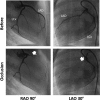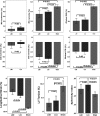Characterizing preclinical models of ischemic heart failure: differences between LAD and LCx infarctions
- PMID: 25217654
- PMCID: PMC4233300
- DOI: 10.1152/ajpheart.00797.2013
Characterizing preclinical models of ischemic heart failure: differences between LAD and LCx infarctions
Abstract
Large animal studies are an important step toward clinical translation of novel therapeutic approaches. We aimed to establish an ischemic heart failure (HF) model with a larger myocardial infarction (MI) relative to previous studies, and characterize the functional and structural features of this model. An MI was induced by occluding the proximal left anterior descending artery (LAD; n = 15) or the proximal left circumflex artery (LCx; n = 6) in Yorkshire pigs. Three pigs with sham procedures were also included. All pigs underwent hemodynamic and echocardiographic assessments before MI, at 1 mo, and 3 mo after MI. Analyses of left ventricular (LV) myocardial mechanics by means of strains and torsion were performed using speckle-tracking echocardiography and compared between the groups. The proximal LAD MI approach induced larger infarct sizes (14.2 ± 3.2% vs. 10.6 ± 1.9%, P = 0.03), depressed systolic function (LV ejection fraction; 39.8 ± 7.5% vs. 54.1 ± 4.6%, P < 0.001), and more LV remodeling (end-systolic volume index; 82 ± 25 ml/m(2) vs. 51 ± 18 ml/m(2), P = 0.02, LAD vs. LCx, respectively) compared with the LCx MI approach without compromising the survival rate. At the papillary muscle level, echocardiographic strain analysis revealed no differences in radial and circumferential strain between LAD and LCx MIs. However, in contrast with the LCx MI, the LAD MI resulted in significantly decreased longitudinal strain. The proximal LAD MI model induces more LV remodeling and depressed LV function relative to the LCx MI model. Location of MI significantly impacts the severity of HF, thus careful consideration is required when choosing an MI model for preclinical HF studies.
Keywords: anterior; posterior; remodeling; sphericity; torsion.
Copyright © 2014 the American Physiological Society.
Figures






Comment in
-
Characterizing preclinical model of ischemic heart failure: difference between LAD and LCx infarctions.Am J Physiol Heart Circ Physiol. 2015 Feb 15;308(4):H364. doi: 10.1152/ajpheart.00807.2014. Am J Physiol Heart Circ Physiol. 2015. PMID: 25684738 Free PMC article. No abstract available.
-
Reply to "Letter to the editor: Characterizing preclinical model of ischemic heart failure: difference between LAD and LCx infarctions".Am J Physiol Heart Circ Physiol. 2015 Feb 15;308(4):H365-6. doi: 10.1152/ajpheart.00855.2014. Am J Physiol Heart Circ Physiol. 2015. PMID: 25684739 No abstract available.
Similar articles
-
Reduced longitudinal contraction is associated with ischemic mitral regurgitation after posterior MI.Am J Physiol Heart Circ Physiol. 2018 Feb 1;314(2):H322-H329. doi: 10.1152/ajpheart.00546.2017. Epub 2017 Nov 3. Am J Physiol Heart Circ Physiol. 2018. PMID: 29101180 Free PMC article.
-
Development of a preclinical model of ischemic cardiomyopathy in swine.Am J Physiol Heart Circ Physiol. 2011 Aug;301(2):H530-7. doi: 10.1152/ajpheart.01103.2010. Epub 2011 May 6. Am J Physiol Heart Circ Physiol. 2011. PMID: 21551276 Free PMC article.
-
Microvascular Dysfunction Related to Progressive Left Ventricular Remodeling due to Chronic Occlusion of the Left Anterior Descending Artery in an Adult Porcine Heart.Int Heart J. 2019 May 30;60(3):715-727. doi: 10.1536/ihj.18-346. Epub 2019 May 17. Int Heart J. 2019. PMID: 31105143
-
Clinical aspects of left ventricular diastolic function assessed by Doppler echocardiography following acute myocardial infarction.Dan Med Bull. 2001 Nov;48(4):199-210. Dan Med Bull. 2001. PMID: 11767125 Review.
-
Searching for Preclinical Models of Acute Decompensated Heart Failure: a Concise Narrative Overview and a Novel Swine Model.Cardiovasc Drugs Ther. 2022 Aug;36(4):727-738. doi: 10.1007/s10557-020-07096-5. Epub 2020 Oct 24. Cardiovasc Drugs Ther. 2022. PMID: 33098053 Free PMC article. Review.
Cited by
-
Characterizing preclinical model of ischemic heart failure: difference between LAD and LCx infarctions.Am J Physiol Heart Circ Physiol. 2015 Feb 15;308(4):H364. doi: 10.1152/ajpheart.00807.2014. Am J Physiol Heart Circ Physiol. 2015. PMID: 25684738 Free PMC article. No abstract available.
-
Preclinical models of congestive heart failure, advantages, and limitations for application in clinical practice.Front Physiol. 2022 Aug 4;13:850301. doi: 10.3389/fphys.2022.850301. eCollection 2022. Front Physiol. 2022. PMID: 35991184 Free PMC article. Review.
-
Left Ventricular Unloading Using an Impella CP Improves Coronary Flow and Infarct Zone Perfusion in Ischemic Heart Failure.J Am Heart Assoc. 2018 Mar 7;7(6):e006462. doi: 10.1161/JAHA.117.006462. J Am Heart Assoc. 2018. PMID: 29514806 Free PMC article.
-
Reduced longitudinal contraction is associated with ischemic mitral regurgitation after posterior MI.Am J Physiol Heart Circ Physiol. 2018 Feb 1;314(2):H322-H329. doi: 10.1152/ajpheart.00546.2017. Epub 2017 Nov 3. Am J Physiol Heart Circ Physiol. 2018. PMID: 29101180 Free PMC article.
-
A refined, minimally invasive, reproducible ovine ischaemia-reperfusion-infarction model using implantable defibrillators: Methodology and validation.Exp Physiol. 2025 Feb;110(2):215-229. doi: 10.1113/EP091760. Epub 2024 Dec 19. Exp Physiol. 2025. PMID: 39702979 Free PMC article.
References
-
- Chow E, Woodard JC, Farrar DJ. Rapid ventricular pacing in pigs: an experimental model of congestive heart failure. Am J Physiol Heart Circ Physiol 258: H1603–H1605, 1990. - PubMed
-
- Deryck YL, Brimioulle S, Maggiorini M, de Canniere D, Naeije R. Systemic vascular effects of isoflurane versus propofol anesthesia in dogs. Anesth Analg 83: 958–964, 1996. - PubMed
-
- Goldberg A, Southern DA, Galbraith PD, Traboulsi M, Knudtson ML, Ghali WA. Coronary dominance and prognosis of patients with acute coronary syndrome. Am Heart J 154: 1116–1122, 2007. - PubMed
-
- Gorcsan J, 3rd, Tanaka H. Echocardiographic assessment of myocardial strain. J Am Coll Cardiol 58: 1401–1413, 2011. - PubMed
-
- Gotte MJ, van Rossum AC, Marcus JT, Kuijer JP, Axel L, Visser CA. Recognition of infarct localization by specific changes in intramural myocardial mechanics. Am Heart J 138: 1038–1045, 1999. - PubMed
Publication types
MeSH terms
Grants and funding
LinkOut - more resources
Full Text Sources
Other Literature Sources
Medical
Research Materials
Miscellaneous

